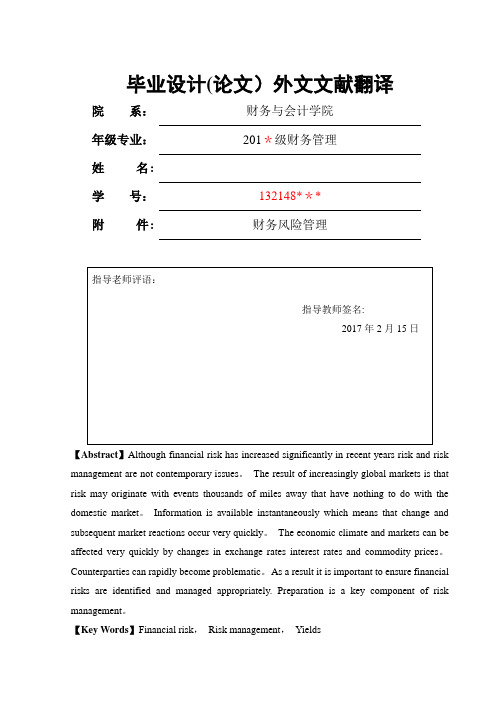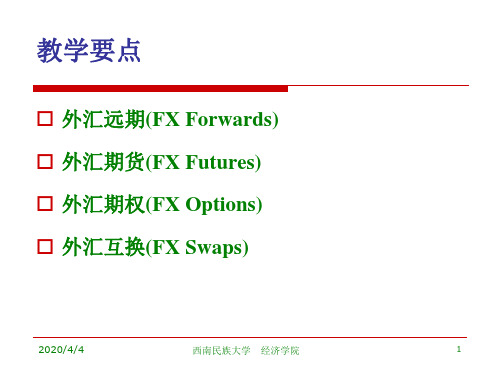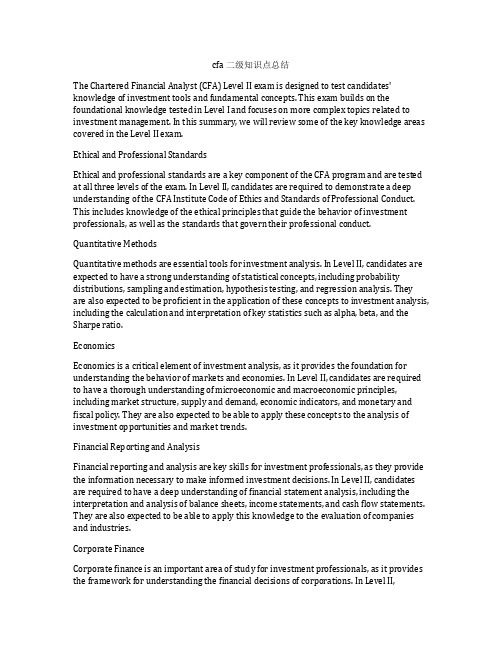Futures,Forwards,Options
options

• Calls vs. Puts
– Call options gives the holder the right, but not the obligation, to buy a given quantity of some asset at some time in the future, at prices agreed upon today. – Put options gives the holder the right, but not the obligation, to sell a given quantity of some asset at some time in the future, at prices agreed upon today
Basic Option Profit Profiles
Profit If the call is inthe-money, it is worth ST – E. If the call is outof-the-money, it is worthless and the –c0 buyer of the call loses his entire investment of c0. loss
definition
• In finance, an option is a derivative financial instrument that specifies a contract between two parties for a future transaction on an asset at a reference price.1 The buyer of the option gains the right, but not the obligation, to engage in that transaction, while the seller incurs the corresponding obligation to fulfill the transaction. The price of an option derives from the difference between the reference price and the value of the underlying asset (commonly a stock, a bond, a currency or a futures contract) plus a premium based on the time remaining until the expiration of the option. Other types of options exist, and options can in principle be created for any type of valuable asset.
毕业设计论文外文文献翻译

毕业设计(论文)外文文献翻译院系:财务与会计学院年级专业:201*级财务管理姓名:学号:132148***附件: 财务风险管理【Abstract】Although financial risk has increased significantly in recent years risk and risk management are not contemporary issues。
The result of increasingly global markets is that risk may originate with events thousands of miles away that have nothing to do with the domestic market。
Information is available instantaneously which means that change and subsequent market reactions occur very quickly。
The economic climate and markets can be affected very quickly by changes in exchange rates interest rates and commodity prices。
Counterparties can rapidly become problematic。
As a result it is important to ensure financial risks are identified and managed appropriately. Preparation is a key component of risk management。
【Key Words】Financial risk,Risk management,YieldsI. Financial risks arising1.1What Is Risk1.1.1The concept of riskRisk provides the basis for opportunity. The terms risk and exposure have subtle differences in their meaning. Risk refers to the probability of loss while exposure is the possibility of loss although they are often used interchangeably。
金融衍生工具

金融衍生工具金融衍生工具,也称金融衍生商品,其“衍生”两字,说明它源于原生性金融商品或称基础性金融工具(Underlying Instruments)。
由于是派生物,金融衍生工具不能独立存在,其价值在相当程度上受制于基础性金融工具。
根据目前发展,基础性金融工具主要有四大类:(1)外汇或者称货币;(2)利率工具,如债券、商业票据、存单等;(3)股票和股价指数;(4)贷款。
虽然基础工具种类不多,但是借助各种技术,在此基础上可以设计出品种繁多、特性不一的衍生工具。
所以,金融衍生工具是一种通过预测股价、利率、汇率等金融工具未来市场行情走势,以支付少量保证金签订远期合同或互换不同金融商品的派生交易合约。
期货(Futures)、期权(Options)、远期合约(Forwards)、掉期(Swap)等均属此类。
一般来说,金融衍生工具可以分为契约型与证券型两大类。
契约型的衍生工具是指订约双方以某种金融工具(股票、外汇等)或金融指数(利率、股指等)为准,决定合约交易的价格,人们比较熟悉的期权、期货就是此类衍生工具。
证券型金融衍生工具以证券形式出现,如抵押证券(Mortgage-backed Security,即以抵押贷款为基础所发行的有价证券)、可转换债券(Convertibles,相当于附有股票买进选择权的债券) 等均属此类。
契约型的金融衍生工具在课本上已经讲述过了,现在主要就证券型的金融衍生工具来做一个介绍。
证券型的金融衍生工具主要有公司认证股权、可转换公司债(可转换债券)和抵押证券等。
一、认证股权认股权证,又称“认股证”或“权证”,其英文名称为Warrant,故在香港又俗译“窝轮”。
是一种约定该证券的持有人可以在规定的某段期间内,有权利(而非义务)按约定价格向发行人购买标的股票的权利凭证。
按照发行主体,认股权证分为股本认股权证和备兑权证两种。
股本认股权证属于狭义的认股权证,是由上市公司发行的。
备兑权证则属于广义认股权证,是由上市公司以外的第三方(一般为证券公司、银行等)发行的,不增加股份公司的股本。
(9)远期、期货和互换

14
注:O/N = over night
15
例:假设A公司在6个月末需要一笔1000万元的资金,为 期3个月,为了锁定资金成本,该公司与某银行签订了一 份6×9的远期利率协议,协议利率为4%,名义本金为 1000万元。如果3月末市场利率上升为4.5%对A公司有何 影响。
18
中国期货品种
(1)上海期货交易所:铜、铝、锌、天然橡胶、燃油、黄 金、螺纹钢、线材 (2)大连商品交易所:大豆、豆粕、豆油、塑料、棕榈油 、玉米、PVC (3)郑州商品交易所:硬麦、强麦、棉花、白糖、pta、菜 籽油、籼稻 (4)中国金融期货交易所:股指期货
19
期货的基本概念: 标准化:合约规模,交割地点,交割日期 初始保证金(initial margin): (5% - 20%) 维持保证金(maintenance margin): 盯市(mark to market):每天交易结束时,根据期货价 格的涨跌调整保证金账户。
跨期套利、跨市套利、跨品种套利 正向套利,反向套利
23
正向套利(cash-and-carry arbitrage): 远期价格 < 交割价格:买入现货,卖出远期。 注:远期价格的高低取决于现价(见后文)。上式表明 现价偏低。
反向套利(reverse cash-and-carry arbitrage): 远期价格 > 交割价格:卖空现货,买入远期。 上式表明现价偏高。
解:这份远期合约的合理价格应该为
F 50e0.100.25 51.27
30
Example: A stock that pays no dividends has a current price of $50. The annual effective risk free rate of return is 5%. Calculate the forward price for purchasing the stock in one year. Solution:
FRM 金融风险管理师考试大纲

Quantitative Analysis Readings:
1. Linda Allen, Jacob Boudoukh, Anthony Saunders, Understanding Market, Credit and Operational Risk: The Value At Risk Approach (Oxford: Blackwell Publishing, 2004). Chapter 2 – Quantifying Volatility in VaR Models th John Hull, Options, Futures, and Other Derivatives, 6 ed. (New York: Prentice Hall, 2006). Chapter 19 – Estimating volatilities and correlations rd Philippe Jorion, Value at Risk: The New Benchmark for Managing Financial Risk, 3 ed. (New York: McGraw-Hill, 2007). Chapter 9 – Forecasting risk and correlations Chapter 12 – Monte Carlo Methods Lampros Kalyvas and Ioannis Akkizidis, Integrated Market, Credit and Operational Risk: A Complete Guide for Bankers and Risk Professionals (London: Risk Books, 2006). Chapter 4 – Extreme Value Theory and in Risk Management Murray R. Spiegel, John Schiller, and R. Alu Srinivasan, Probability and Statistics, Schaum’s Outlines, 2nd ed. (New York: McGraw-Hill, 2000). Chapter 1 – Basic Probability Chapter 2 – Random Variables and Probability Distributions Chapter 3 – Mathematical Expectation Chapter 4 – Special Probability Distributions Chapter 5 – Sampling Theory Chapter 6 – Estimation Theory Chapter 7 – Tests of Hypotheses and Significance Chapter 8 – Curve Fitting, Regression, and Correlation NOTE: Candidates should not memorize formulas of distributions but should understand when it is appropriate to use a particular type of distribution.
外汇衍生产品市场

西南民族大学 经济学院
6
报价方法
远期汇率直接报价法
外汇银行直接报远期汇率 瑞士、日本等国采用此法
远期差价报价法
外汇银行在即期汇率之外,标出远期升贴水 也可采用报标准远期升贴水的做法
掉期率报价法
外汇银行在即期汇率之外,标出掉期率
2020/4
原理:是指外汇买卖成交后客户可以在将来的
2020/4/4
西南民族大学 经济学院
17
远期汇率的确定
利息平价定理
如果两种相似金融工具的预期收益不同,资金就会从一 种工具转移到另一种工具
相似金融工具的预期收益率相等时达到均衡
国际金融套利
如果经过汇率调整,一国某种金融工具的预期收益率仍 高于另一国相似金融工具,资金就会跨国移动
资金在国际间的转移,必然影响相关国家可贷资金市场 的供求,影响利率水平,进而影响到汇率
2020/4/4
西南民族大学 经济学院
3
外汇远期交易
本质上是一种预约买卖外汇的交易
买卖双方签订合同,约定买卖外汇的币种、数 额、汇率和交割时间
到规定的交割日期或在约定的交割期内,按照
合同规定条件完成交割
2020/4/4
西南民族大学 经济学院
4
外汇远期分类
定期外汇远期交易
固定交割日期
在成交日顺延相应远期期限后进行交割
2020/4/4
西南民族大学 经济学院
15
例3
假定银行报出美元/日元的即期汇率为98.50/80, 15天的掉期率为30-40 30天的掉期率为50-40,
请问客户购买15天美元、30天日元的远期择期汇价 (买入价或卖出价)各为多少?
2020/4/4
西南民族大学 经济学院
cfa二级知识点总结

cfa二级知识点总结The Chartered Financial Analyst (CFA) Level II exam is designed to test candidates' knowledge of investment tools and fundamental concepts. This exam builds on the foundational knowledge tested in Level I and focuses on more complex topics related to investment management. In this summary, we will review some of the key knowledge areas covered in the Level II exam.Ethical and Professional StandardsEthical and professional standards are a key component of the CFA program and are tested at all three levels of the exam. In Level II, candidates are required to demonstrate a deep understanding of the CFA Institute Code of Ethics and Standards of Professional Conduct. This includes knowledge of the ethical principles that guide the behavior of investment professionals, as well as the standards that govern their professional conduct.Quantitative MethodsQuantitative methods are essential tools for investment analysis. In Level II, candidates are expected to have a strong understanding of statistical concepts, including probability distributions, sampling and estimation, hypothesis testing, and regression analysis. They are also expected to be proficient in the application of these concepts to investment analysis, including the calculation and interpretation of key statistics such as alpha, beta, and the Sharpe ratio.EconomicsEconomics is a critical element of investment analysis, as it provides the foundation for understanding the behavior of markets and economies. In Level II, candidates are required to have a thorough understanding of microeconomic and macroeconomic principles, including market structure, supply and demand, economic indicators, and monetary and fiscal policy. They are also expected to be able to apply these concepts to the analysis of investment opportunities and market trends.Financial Reporting and AnalysisFinancial reporting and analysis are key skills for investment professionals, as they provide the information necessary to make informed investment decisions. In Level II, candidates are required to have a deep understanding of financial statement analysis, including the interpretation and analysis of balance sheets, income statements, and cash flow statements. They are also expected to be able to apply this knowledge to the evaluation of companies and industries.Corporate FinanceCorporate finance is an important area of study for investment professionals, as it provides the framework for understanding the financial decisions of corporations. In Level II,candidates are required to have a strong understanding of capital budgeting, cost of capital, and capital structure. They are also expected to be able to apply this knowledge to the evaluation of investment opportunities and the determination of optimal capital structures for companies.Equity InvestmentsEquity investments are a core component of many investment portfolios, and candidates are required to have a strong understanding of equity valuation methods, including dividend discount models, discounted cash flow analysis, and relative valuation techniques. They are also expected to be able to apply these methods to the valuation of individual stocks and equity portfolios.Fixed IncomeFixed income securities are an important asset class for many investors, and candidates are required to have a deep understanding of the characteristics and valuation of fixed income securities, including bonds, mortgage-backed securities, and floating rate notes. They are also expected to be able to apply this knowledge to the analysis of fixed income portfolios and the assessment of interest rate risk.DerivativesDerivatives are complex financial instruments that are used to manage risk and speculate on market movements. In Level II, candidates are required to have a strong understanding of the characteristics and valuation of futures, forwards, options, and swaps. They are also expected to be able to apply this knowledge to the analysis of derivative strategies and the assessment of derivative instruments.Alternative InvestmentsAlternative investments, such as private equity, hedge funds, and real estate, are an important component of many investment portfolios, and candidates are required to have a deep understanding of these asset classes. In Level II, candidates are expected to have a strong understanding of the characteristics and valuation of alternative investments, as well as the risks and opportunities associated with these asset classes.Portfolio ManagementPortfolio management is the process of constructing and managing investment portfolios, and candidates are required to have a thorough understanding of the principles and practices of portfolio management. In Level II, candidates are expected to be able to apply their knowledge of asset allocation, portfolio construction, and performance evaluation to the management of investment portfolios.Overall, the Level II exam covers a wide range of topics related to investment management, including ethical and professional standards, quantitative methods, economics, financialreporting and analysis, corporate finance, equity investments, fixed income, derivatives, alternative investments, and portfolio management. Candidates are required to have a deep understanding of these topics in order to pass the exam and earn the CFA designation.。
CFA衍生工具(Derivatives)考点解析20200129

CFA衍生工具(Derivatives)考点解析对于很多想参加CFA考试的同学来说,对于CFA的考试内容还不是很了解。
我就为大家分享一下CFA考试的考试科目:1、道德与职业行为标准(Ethics and Professional Standards)2、定量分析(Quantitative)3、经济学(Economics)4、财务报表分析(Financial Statement Analysis)5、公司理财(Corporate Finance)6、权益投资(Equity Investments)7、固定收益投资(Fixed Income)8、衍生工具(Derivatives)9、其他类投资(Alternative Investments)10、投资组合管理(Portfolio Management)Derivatives(金融衍生品)很多CFA考生都认为一级里的Derivatives(金融衍生品)非常难,碰到这个章节就觉得十分头疼。
好在这个部分在考试中占比仅为5%,有些考生甚至采取了丢车保帅的做法。
提醒大家,不必对此产生畏难情绪。
CFA一级考试金融衍生品科目考试以前有一些计算,但现在以定性题目为主,要求考生能理解其中原由,难度有所下降。
随着国内逐渐开放衍生品市场,越来越需要有衍生品专业知识的人才。
这部分的衍生品主要介绍衍生品的一些基本知识,包括衍生品的种类及市场区分,4大类衍生品的基本定价原理,以及简单期权策略。
CFA一级考试的Derivatives(金融衍生品)具体的内容知识点包含1个study session,3个reading。
其中,Reading 57对衍生品市场进行了区别,并对4大类衍生品进行了基本定义;Reading 58讲衍生品的定价和估值的基本原理,并对4大类衍生品的基本定价做了介绍;Reading 59对期权做了进一步分析,介绍两种期权及两种期权策略的应用。
从CFA考试的重要度来看,Reading 58、Reading 59是最重要的,Reading 57其次,其他Reading重要性不大。
